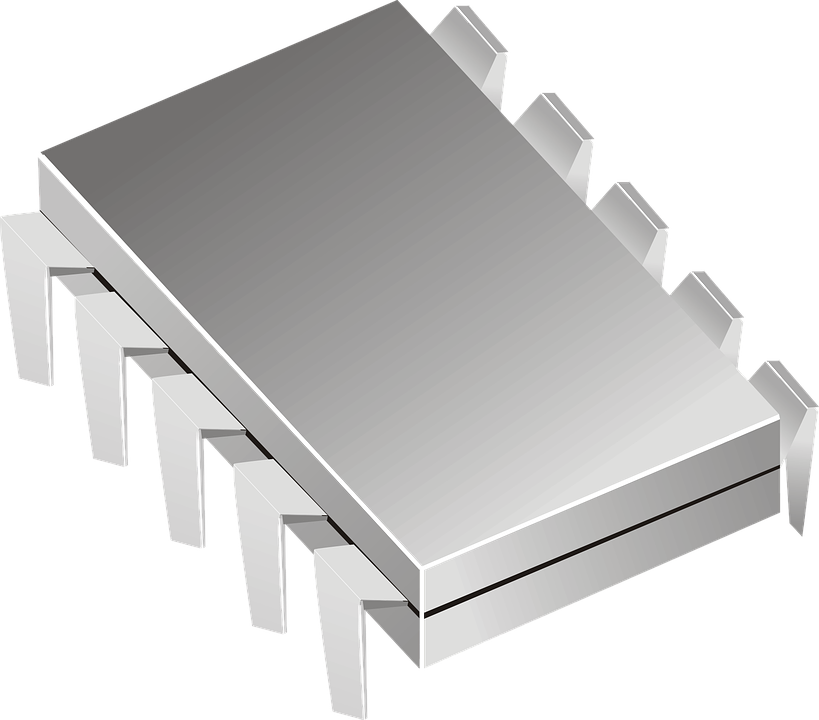Semiconductors
Some substances allow passing of electricity through them examples being Steel, Aluminium, Silver, Copper etc. They are called conductors. Whereas, some substances do not allow passing of electricity through them examples being wood, rubber etc. They are called insulators. But, there are substances which do not conduct electricity like metals but conduct to some extent, they are called semiconductors. The commonly used semiconductors are Silicon and Germanium. Silicon is used in Transistors, junction diodes etc. which has revolutionized modern computing. The picture below is of an integrated circuit in which semiconductors are used.

Chracteristics
i. Resistivity is higher than that of metals. Resistivity is a property of a substance to resist the flow of electricity through them. They are less conductivity means they resist more to flow of electricity obviously.
ii. The temperature coefficient of resistance is negative. In general, when temperature increases in metal, the motion of electrons becomes random and it resists the flow more. That means resistivity in metal increases with temperature. But, in semiconductor, with an increase in temperature, the resistivity decreases.
ρ-ρ0 = ρ0 α Δ(θ- θ0)
ρ0= resistivity ar temperature θ0
ρ= resistivity ar temperature θ
α = Temperature coefficient.
For metals, α >0
when θ> θ0; ρ > ρ0
For semiconductors, α <0
when θ< θ0; ρ < ρ0
iii. On adding the metal impurities the conductivity increases.
iv. Usually in metallic appearance but hard and brittle.
Types
There are two types of semiconductors; Intrinsic and Extrinsic semiconductor.
i. Intrinsic Semiconductor:
When Silicon and Germanium semiconductors are used purely without adding any external impurities then this type of semiconductor is called intrinsic semiconductor. At absolute zero temperature(T= 0 K), it doesn't conduct electricity. When temperature increase then their bond decompose and the some of the electrons get free. Due to the less free electron, its conductivity is very less. So, impurities should be added to increase conductivity significantly.
ii. Extrinsic Semiconductor:
The extrinsic semiconductors are those in which external impurities or doping agent are added in very small amount. About 1 impure atom is added in 10^8 pure atoms. Pure atoms are that of Silicon and Germanium. Doping atoms are generally pentavalent or trivalent atoms. Pentavalent atoms are those atoms which have 5 valence electrons and trivalent atoms are one which have 3 valence electrons. Generally, Boron(trivalent) and Phosphorous(pentavalent) impurities are added.
Sources:
i. Image from (https://pixabay.com/)
ii. Science and Engineering of Materials (http://www.springer.com/us/book/9781489928955)
Hello, Riemannian, Let me welcome you to Steemit. Hope you gonna have fun with our community. Feel free to follow me @rightuppercorner Have a great time @rightuppercorner
Downvoting a post can decrease pending rewards and make it less visible. Common reasons:
Submit
followed you
Downvoting a post can decrease pending rewards and make it less visible. Common reasons:
Submit
Hi, riemannian! I just resteemed your post!
I can also re-steem and upvote some of your other posts
Curious? Check out @resteembot's' introduction post
PS: If your reputation is lower than 30 re-blogging with @resteembot only costs 0.001 SBD
Downvoting a post can decrease pending rewards and make it less visible. Common reasons:
Submit
Thank you for resteeming :D
Downvoting a post can decrease pending rewards and make it less visible. Common reasons:
Submit
Semiconductors are materials with electrical conductivity between conductors and insulators. They are essential in electronics, enabling control of electrical flow. Common types include silicon and germanium. For instance, Littelfuse's K2400GHU is a semiconductor component known for its reliability and efficiency in various applications. Learn more at https://www.dyethin.com/productdetails/littelfuse-inc-k2400ghu.
Downvoting a post can decrease pending rewards and make it less visible. Common reasons:
Submit